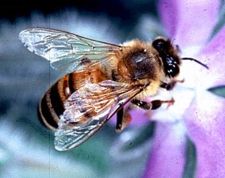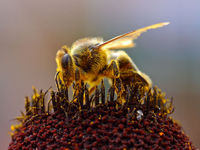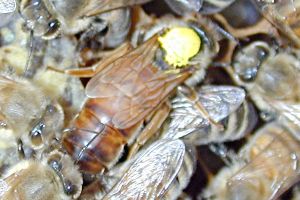Honey bee
2007 Schools Wikipedia Selection. Related subjects: Insects, Reptiles and Fish
| iHoney bees | ||||||||||||||
|---|---|---|---|---|---|---|---|---|---|---|---|---|---|---|
 |
||||||||||||||
| Scientific classification | ||||||||||||||
|
||||||||||||||
|
|
||||||||||||||
|
Apis andreniformis |
Honey bees (or honeybees) are a subset of bees which represent a far smaller fraction of bee diversity than most people suspect; of the approximately 20,000 known species of bees, there are only seven presently-recognized species with a total of 44 subspecies (Engel, 1999; historically, anywhere from six to eleven species have been recognized). These bees are the only living members of the tribe Apini, all in the genus Apis, and all of which produce and store liquified sugar ("honey") to some degree, and construct colonial nests out of wax secreted by the workers in the colony. Other types of related bee produce and store honey, but only members of the genus Apis are considered true honey bees.
Origin and distribution of the genus Apis
Honey bees as a group appear to have their centre of origin in Southeast Asia (including the Philippines), as all but one of the extant species are native to that region, including the most primitive living species ( Apis florea and A. andreniformis). The first Apis bees appear in the fossil record in deposits dating about 35 million years ago during the Oligocene period; that these fossils are from Europe does not necessarily indicate that Europe is where the genus originated, as the likelihood of fossils being found in Southeast Asia is very small, even if that is the true origin. The ancestors and close relatives of modern honey bees were all already social and so social behaviour predates the origin of the genus. Among the extant members of the genus, the more ancient species make single, exposed combs, while the more recently-evolved species nest in cavities and have multiple combs, which has greatly facilitated their domestication.
Most species have historically been cultured or at least exploited for honey and beeswax by humans indigenous to their native ranges. Only two of these species have been domesticated, one ( Apis mellifera) at least since the time of the building of the Egyptian pyramids, and only that species has been moved extensively beyond its native range.
Common Species
Common (or European)
Apis mellifera, the most commonly domesticated species, is the third insect to have its genome mapped. It originated in Tropical Africa and spread from there to Northern Europe and East into Asia. It is also called the Western honey bee. There are many sub-species that have adapted to the environment of their geographic and climatic area. Behavior, colour and anatomy can be quite different from one sub-species or race to another. In 1622, first European colonists brought the sub-species Apis mellifera mellifera to the Americas. Many of the crops that depend on honey bees for pollination have also been imported since colonial times. Escaped swarms (known as wild bees, but actually feral) spread rapidly as far as the Great Plains, usually preceding the colonists. The Native Americans called the honey bee "the white man's fly". Honey bees did not naturally cross the Rocky Mountains; they were carried by ship to California in the early 1850s. The so-called " killer bee" is a strain of this species, with ancestral stock of African origin (thus often called "Africanized").
Dwarf and Eastern
- Apis florea and Apis cerana are small honey bees of southern and southeastern Asia. The former makes very small, exposed nests in trees and shrubs, while the latter makes nests in cavities and is sometimes managed in hives in a similar fashion to Apis mellifera, though on a much smaller and regionalized scale. Their stings are often not capable of penetrating human skin, so the hive and swarms can be handled with minimal protection.
Giant
- Apis dorsata, the giant honey bee, is native to south and southeastern Asia, and usually makes its exposed combs on high tree limbs, or on cliffs, and sometimes on buildings. It is wild and can be very fierce. It is robbed of its honey periodically by human honey gatherers, a practice known as honey hunting. Its colonies are easily capable of stinging a human being to death when provoked.
Beekeeping
Two species of honey bee, A. mellifera and A. cerana, are often maintained, fed, and transported by beekeepers. Modern hives also enable beekeepers to transport bees, moving from field to field as the crop needs pollinating and allowing the beekeeper to charge for the pollination services they provide, revising the historical role of the self-employed beekeeper, and favoring large-scale commercial operations. For further information see the main article, or the articles for these species.
Life cycle
Like other eusocial bees, a colony generally contains one breeding female, or " queen"; seasonally up to a few thousand males, or " drones"; and a large seasonally variable population of sterile female workers. Many minor details vary among the different species of honeybees, though there are some common features. Eggs are laid singly in a cell in a wax honeycomb, produced and shaped by the workers. Larvae are initially fed with royal jelly produced by worker bees, later switching to honey and pollen. The exception is a larva fed solely on royal jelly, which will develop into a queen bee. The larva undergoes several moltings before spinning a cocoon within the cell, and pupating.
Young worker bees clean the hive and feed the larvae. After this, they begin building comb cells. They progress to other within-colony tasks as they become older, such as receiving nectar and pollen from foragers. Later still, a worker leaves the hive and typically spends the remainder of its life as a forager.
Workers cooperate to find food and use a pattern of "dancing" (known as the bee dance or waggle dance) to communicate with each other; this dance varies from species to species, but all living species of Apis exhibit some form of the behaviour.
Virgin queens go on mating flights away from their home colony, and mate with multiple drones before returning. The drones die in the act of mating.
Colonies are established not by solitary queens, as in most bees, but by groups known as " swarms" which consist of a mated queen and a large contingent of workers. This group moves en masse to a nest site that has been scouted by workers beforehand, and once they arrive they immediately construct a new comb and begin to raise a new worker brood. This type of nest founding is not seen in any other living bee genus, though there are several groups of Vespid wasps which also found new nests via swarming (sometimes including multiple queens). Also, stingless bees will start new nests with large numbers of workers, but the nest is constructed before a queen is escorted to the site, which is not a true "swarm".
Products
Pollination
Species of Apis are generalist floral visitors, and will pollinate a large variety of plants, but by no means all plants. Of all the honeybee species, only Apis mellifera has been used extensively for commercial pollination of crops and other plants. The value of these pollination services is commonly measured in the billions of dollars.
Honey
Honey is the complex substance made when the nectar and sweet deposits from plants and trees are gathered, modified and stored in the honeycomb by honey bees. All living species of Apis have had their honey gathered by indigenous peoples for consumption, though for commercial purposes only A. mellifera and A. cerana have been exploited to any degree. Honey is sometimes also gathered by humans from the nests of various Stingless bees.
Beeswax
Worker bees of a certain age will secrete beeswax from a series of glands on their abdomen. They use the wax to form the walls and caps of the comb. As with honey, most indigenous peoples will gather beeswax for various purposes.
Pollen
Bees collect pollen in the pollen basket and carry it back to the hive. In the hive, pollen is used as a protein source necessary during brood-rearing. In certain environments, excess pollen can be collected from the hives of A. mellifera and A. cerana. It is often eaten as a health supplement.
Propolis
Propolis (or bee glue) is created from resins, balsams and tree saps. Those species of honey bees which nest in tree cavities use propolis to seal cracks in the hive. Propolis is also used in some cosmetics.
Defense
All honey bees live in colonies where the workers will sting intruders as a form of defense, and release pheromones that accentuate the attack response. The different species of honey bees are distinguished from all other bee species by the possession of small barbs on the sting, but these barbs are found only in the workers. The sting and associated venom sac are also modified so as to pull free of the body once lodged ( autotomy), and the sting apparatus has its own musculature and ganglion which allow it to keep delivering venom once detached. It is presumed that this complex apparatus, including the barbs on the sting, evolved specifically in response to predation by vertebrates, as the barbs do not function (and the sting apparatus does not detach) unless the sting is embedded in fleshy tissue.
Communication
Honey bees are known to communicate through many different chemicals and odours, as is common in insects, but also using specific behaviors that convey information about the quality and type of resources in the environment, and where these resources are located. The details of the signalling being used vary from species to species; for example, the two smallest species, Apis andreniformis and Apis florea, dance on the upper surface of the comb, which is horizontal (not vertical, as in other species), and workers orient the dance in the actual compass direction of the resource to which they are recruiting.




